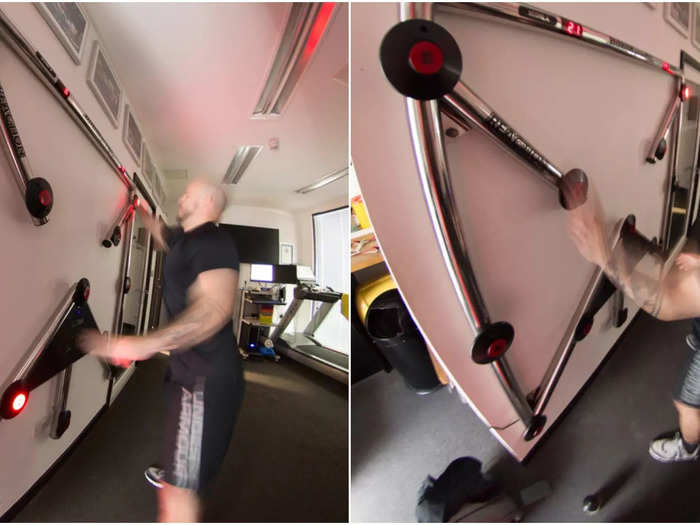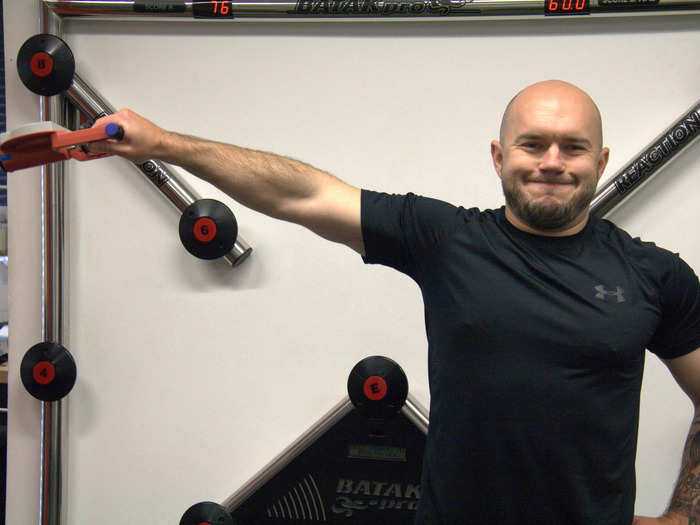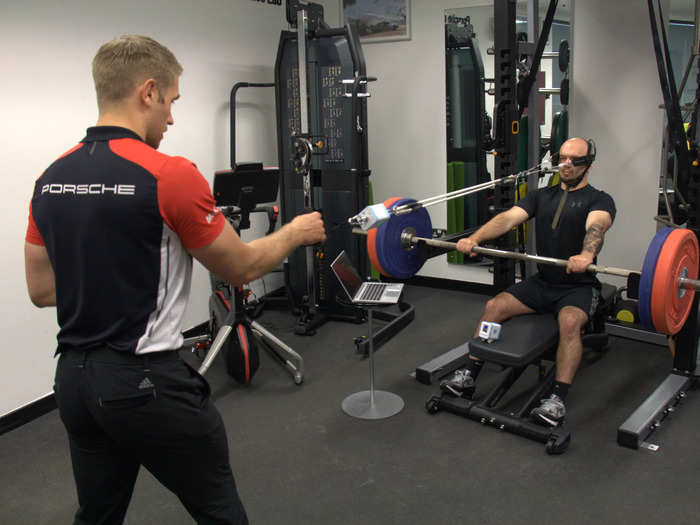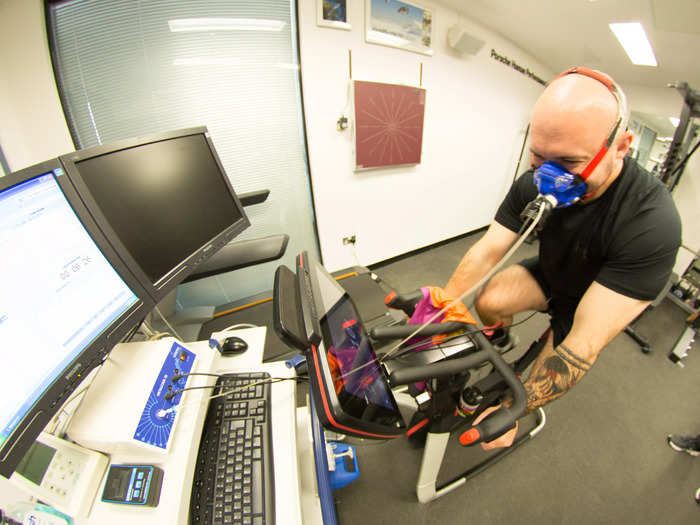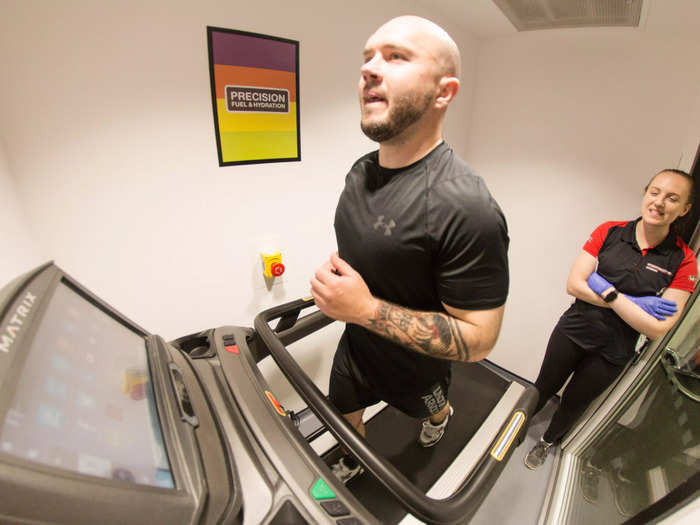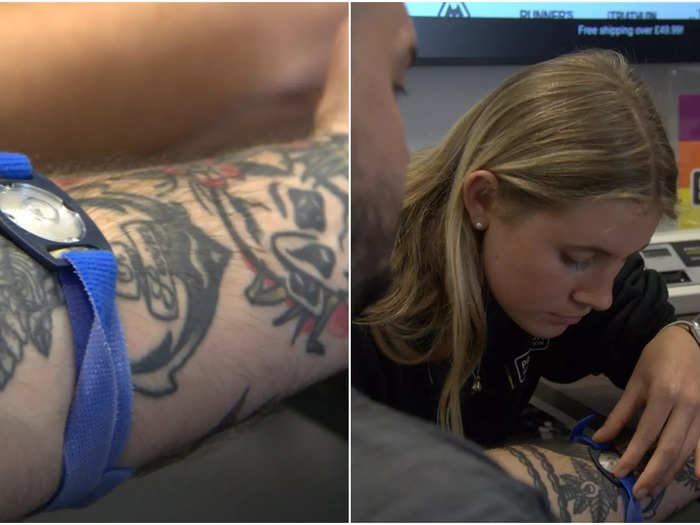Ouch.Sway PR/Mark Hayward
- I underwent testing to highlight the fitness, strength, and speed it requires to be an F1 driver.
- I had my neck strength, grip, coordination, and cardiovascular fitness measured.
"Formula One drivers don't need to be fit, they just sit in a car and go around a track!" — Soccer fan in bar, 2022.
Whether from a friend, a family member, or just a local punter you met on the town, you've likely heard something similar if you've ever found yourself in a conversation about F1.
At face value, it's not a completely unjust assumption to make. Surely, driving a racecar doesn't require you to be as fit and healthy as a tennis player, a basketball player, or a gymnast?
Well, it does, and I found out the hard way.
Courtesy of Precision Fuel & Hydration, I headed to the Porsche Human Performance Lab at Silverstone, home of the British Grand Prix, to undergo a series of tests that highlight the fitness, strength, and coordination required to be an F1 driver.
Before we started, I had my body composition analyzed.
Standing barefoot on a fancy machine, I had my weight, Body Mass Index (BMI), lean muscle percentage, and body fat percentage recorded.
My height was also measured.
These metrics were important for comparing my body composition to that of an F1 driver, as well as for comparing the results of the upcoming tests.
The first test was one based around hand-eye coordination and speed.
This was actually fun. Sway PR/Mark Hayward
A BATAK is a piece of sports equipment designed to test and improve speed, hand-eye coordination, and stamina.
Essentially, it's a large frame that has red lights positioned in various locations. When a red light comes on, you press it was fast as you can, and repeat. The idea is to get as many as you can within a certain timeframe.
I had two attempts, each lasting one minute. I somehow managed to score 77 both times.
While I was pretty impressed with my effort, Porsche strength and conditioning coach Jack Wilson, who was putting me through my paces on the day, said F1 drivers usually manage a minimum of 120 and sometimes upwards of 160.
We then tested my grip.
There is literally no way to look good doing this. Sway PR/Mark Hayward
In the easiest test of the day, my job here was to simply grip what is known as a dynomometer as hard as I would with both hands and measure the amount of force that each could produce.
I scored just over 50kg with both my left and right hands.
F1 drivers, who typically weigh around 30kg less than me, tend to score closer to 70kg on each hand.
Next, we moved onto testing my neck strength.
Again, ouch. Sway PR/Mark Hayward
F1 drivers are subject to high levels of G-force when driving. In a normal race, drivers experience between 4 G and 6.5 G while accelerating, braking and cornering. In crashes, the forces can rise above 180 Gs
Moving at such levels of G-force places extreme stress on the neck muscles.
To test the strength of my neck, I pushed my head as hard as possible against a dynomometer strapped around my head in four directions to measure how much weight I could withstand through my neck.
My scores of around 16kg, 20kg, 20kg, and 22kg were, in Jack's words, very impressive, but still a long way off what you would expect from an F1 driver, which is around 35kg in all directions.
After this, I was then strapped into a rather scary looking device, which simulated different levels of G-force through your neck as you would experience them in an F1 car.
Jack put around 3.5 G through my neck, which was very uncomfortable, but still just over half what a driver usually experiences.
Lastly was an endurance test.
"You merely adopted the dark; I was born in it." Sway PR/Mark Hayward
A person's VO2 max is a measure of the amount of oxygen your body can use per kilogram of bodyweight per minute (mL/kg/min).
Generally the higher you score, the fitter you are.
To test mine, I rode a stationary bike for as long as possible as the resistance increased. A mask strapped to my face recorded my oxygen consumption, while a heart monitor strapped to my chest recorded my heart rate.
I went for just over eight minutes and was given a score of a little more than 36 mL/kg/min.
F1 drivers typically record minimum VO2 max scores of 60 mL/kg/min, but it's not uncommon for them to be as high as 80.
With testing over, I moved on to a cool down, in a heat chamber.
My face says it all. Sway PR/Mark Hayward
As if having a truckload of weight pushed and pulled through my neck and cycling to exhaustion with a gas mask strapped to my face wasn't enough, I next moved on to experience the Porsche Human Performance Lab's very own heat chamber.
Though not a test, I went for a jog in the chamber for five minutes with the temperature set at 40°C, or 104°F.
It was enough to make me feel very overheated and sweat a lot.
An intern helping with the day's activities told me that F1 drivers usually train in the chamber for an hour at a time to try to emulate the sorts of conditions they would experience in the cockpit at hotter circuits, such as in Bahrain or Mexico.
To conclude the day I had a sweat test done.
Precision Fuel & Hydration work with athletes across the world. Sway PR/Mark Hayward
Using a machine that maximally stimulates the sweat glands in a small part of your arm, the people from Precision Fuel & Hydration, who work with F1 drivers, triathletes, and Premier League soccer players, were able to measure how much sodium I lose in my sweat.
Sodium is a key electrolyte that helps regulate muscle contraction, nerve function, and blood volume. Losing too much can cause cramps and have a detrimental effect on athletic performance.
The test showed that I lost around 110mg/l of sodium, making me a "moderately salty sweater."
While the result of this isn't comparable to others because it's usually genetically determined, it's a useful figure to know so you, or elite athletes such as F1 drivers, can work out a hydration strategy to ensure performance is not negatively impacted by losing excessive amounts of sodium.
Sadly, the day proved I'm not cut out for F1.
Looking at the results of all of my tests, it turns out that I'm too heavy, too unfit, too weak, and too slow to be an F1 driver.
Hardly shocking news, but what the day did prove was just how impressive F1 drivers are as athletes.
Not only do drivers have to have inordinately strong grip, necks made of steel, super fast reflexes, and superb cardiovascular fitness, but they also have to be able to perform under extreme conditions unlike any other sport.
So next time you hear someone claim that F1 drivers "just sit in a car and go around a track!" – point them here.

